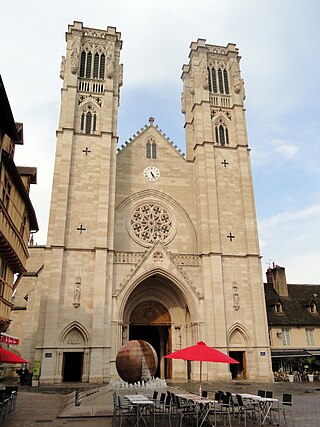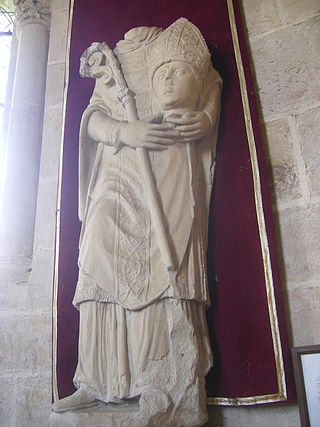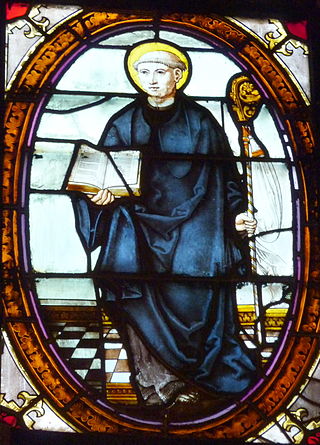This article needs additional citations for verification .(April 2016) |
Saint Nectarius of Autun (French : Nectaire d'Autun) was a 6th-century bishop of Autun, [1] and a saint of the Roman Catholic Church.
This article needs additional citations for verification .(April 2016) |
Saint Nectarius of Autun (French : Nectaire d'Autun) was a 6th-century bishop of Autun, [1] and a saint of the Roman Catholic Church.
Nectarius was bishop of Autun from 540 to his death on 13 September 549 or 550. He was a friend of Saint Germain of Paris, whom he appointed abbot of the Abbey of St. Symphorian, Autun.
The first cathedral of Autun was consecrated during his episcopate. In 542, Nectarius travelled to Milan to venerate the relics of Saint Nazarius, and although he was unable to obtain any of them for Autun, he was offered a piece of cloth covered with the blood of Nazarius and his companion Celsus, which on his return he gave to the new cathedral, which was then dedicated to Nazarius.
During this trip, he met Emanus, a Cappadocian pilgrim who, after living seven years in Rome and Italy, was going to Autun, attracted by a vision of the tomb of Saint Symphorian. The bishop kept him as a guest for several years, after which Emanus went to evangelize the country of the Carnutes. His veneration for Saint Symphorian brought him back to Autun, where he attracted crowds by his miracles. [2]
In 549, Nectarius participated in the Fifth Council of Orléans, [3] together with Saint Germain and seventy-one archbishops and bishops of France. [4]
He died in Autun on 13 September 549 or 550.
His feast day is 13 September. [5]

Autun is a subprefecture of the Saône-et-Loire department in the Bourgogne-Franche-Comté region of central-eastern France. It was founded during the Principate era of the early Roman Empire by Emperor Augustus as Augustodunum to give a Roman capital to the Gallic people Aedui, who had Bibracte as their political centre. In Roman times the city may have been home to 30,000 to 100,000 people, according to different estimates. Nowadays, the commune has a population of about 15,000.

Germain was the bishop of Paris and is venerated as a saint in both the Catholic Church and the Eastern Orthodox Church. According to an early biography, he was known as Germain d'Autun, rendered in modern times as the "Father of the Poor".

The Diocese of Coutances (–Avranches) is a Latin diocese of the Catholic Church in France. Its mother church is the Cathedral of Coutance in the commune of Coutances in France. The diocese is suffragan of the Archbishop of Rouen and comprises the entire department of Manche. It was enlarged in 1802 by the addition of the former Diocese of Avranches and of two archdeaconries from the Diocese of Bayeux. Since 1854 its bishops have held the title of Bishop of Coutances (–Avranches).

Benignus of Dijon was a martyr honored as the patron saint and first herald of Christianity of Dijon, Burgundy. His feast falls, with All Saints, on November 1; his name stands under this date in the Martyrology of St. Jerome.

Amator(in French)Amadour or Amatre was bishop of Auxerre from 388 until his death on 1 May 418 and venerated as a saint in the Catholic Church. Amator's feast day is celebrated on 1 May.

The Diocese of Autun (–Chalon-sur-Saône–Mâcon–Cluny), more simply known as the Diocese of Autun, is a Latin Church diocese of the Catholic Church in France. The diocese comprises the entire Department of Saone et Loire, in the Region of Bourgogne.

The Cathedral of Saint Lazarus of Autun, commonly known as Autun Cathedral, is a Roman Catholic cathedral in Autun and a national monument of France. Famous for its Cluniac inspiration and its Romanesque sculptures by Gislebertus, it is a highlight of Romanesque art in Burgundy. It is the seat of the Bishop of Autun. The Bishop of Autun set forth the construction of St. Lazarus Cathedral as a result of the large movement of pilgrims travelling to Vezelay as they progressed on the pilgrimage route to Santiago de Compostela.

Symphorian, Timotheus (Timothy), and Hippolytus of Rome are three Christian martyrs who, though they were unrelated and were killed in different places and at different times, shared a common feast day in the General Roman Calendar from at least the 1568 Tridentine calendar to the Mysterii Paschalis. While still a young man, Symphorian was either beheaded or beaten to death with clubs.

Saint Aprunculus of Trier was Bishop of Trier from the death of his predecessor, Fibicius, around 525, He served in that capacity until his own death in 526, and was succeeded by Nicetius.

The Diocese of Nevers is a Latin Church diocese of the Catholic Church in France. The diocese comprises the department of Nièvre, in the Region of Bourgogne.

The former French Catholic diocese of Chalon-sur-Saône existed until the French Revolution. After the Concordat of 1801, it was suppressed, and its territory went to the diocese of Autun. Its see was Chalon Cathedral.
Virgilius of Arles was Archbishop of Arles in Gaul.

The Martyrdom of Saint Symphorian is an 1834 painting by the French artist Jean-Auguste-Dominique Ingres. It shows the death of Saint Symphorian, the first Christian martyr in Gaul. Painted in oil on canvas and measuring 407 x 339 cm, it is now in Autun Cathedral. Although Ingres considered the painting—completed only after ten years of diligent work—one of his crowning achievements, it was criticized harshly when he exhibited it in the Paris Salon of 1834. It subsequently has been considered emblematic of Ingres' misguided ambition to excel as a history painter.

Saint Reverianus of Autun was a 3rd-century bishop of Autun and martyr. He is venerated as a saint by the Roman Catholic Church. According to tradition, Reverianus was of Italian origin, he was sent by Pope Felix I to evangelize the Aedui, a Gallic people of Gallia Lugdunensis and is considered the "apostle of the Morvan".

The Abbey of St. Symphorian, Autun, is a former abbey, later a priory, of Benedictine monks located outside the walls of Autun in Burgundy, France.

Saint Euphronius of Autun was a bishop of Autun between 450 and 490. According to Dom Basil Watkins OSB, Euphronius "was one of the greatest bishops of Gaul..."in the 5th century.

Saint Mederic or Medericus, also known in French as Saint Merri or Médéric, was a monk and a hermit, who is considered patron saint of the right bank of the river Seine in central Paris.
Frodulphe de Barjon, known as Saint Frou, born in the 7th century at Autun, and died in the 8th century at Barjon, was a religious and holy French Catholic, a disciple of Saint Mederic.
Jean VI Rolin or Rollin, often referred to as Jean II Rolin to differentiate him from his father Jean Rolin or Rollin in the succession of the offices of Bishop of Autun, abbot of the Abbey of St. Martin, Autun, and prior of the Abbey of Saint-Marcel-lès-Chalon, was a French bishop.
Saint Droctoveus was a Frankish abbot, the first abbot of what became Saint Germain-des-Pres in Paris.